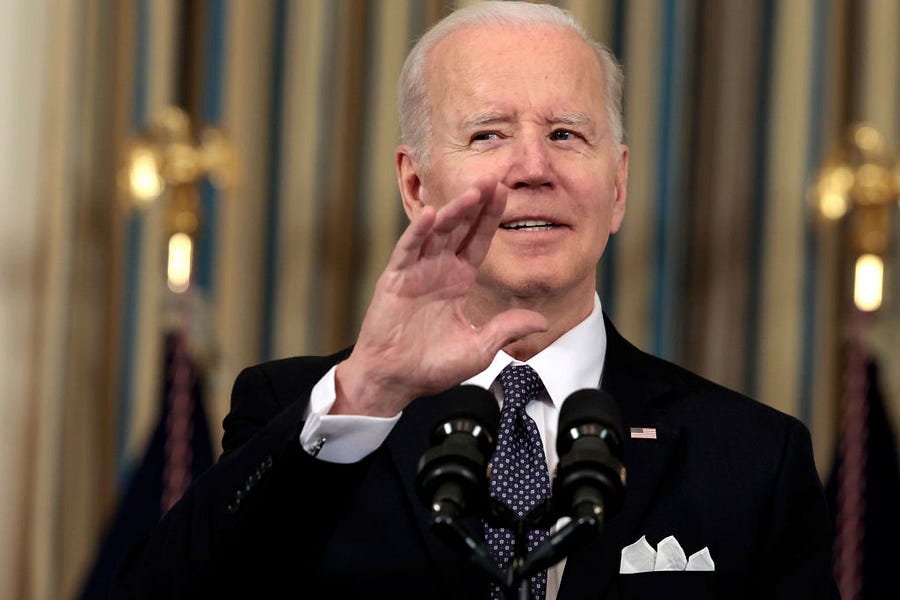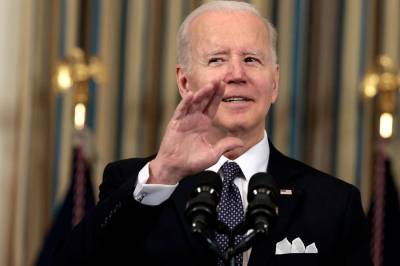The Biden White House has found a new way to make its spending-and-tax proposals appear less expensive: Simply don’t count them in the budget totals.
The president’s long-awaited (and delayed) fiscal year 2023 budget counts as the first “real” budget proposal of the Biden administration. (These budgets usually take more than a year to produce, and so last year’s version by a brand-new administration was understandably rushed and truncated.) This year’s budget was expected to flesh out the details of President Biden’s incredibly expensive agenda.
At first glance, Biden proposes $1.4 trillion in additional spending and $2.5 trillion in new taxes over the decade. Discretionary spending, education, and public health increases would be matched with massive corporate tax hikes. By 2032, the deficit would rise to $1.8 trillion, and total deficits would exceed $14 trillion over the next decade. Still, the White House points to federal spending reaching 23.9 percent of GDP, and taxes reaching 19.1 percent of GDP a decade from now—significantly higher than normal, but not revolutionary.
During the 2020 campaign, Biden proposed $11 trillion in new spending over the decade. Has the White House scaled back or abandoned its more expensive proposals? No. It simply did not include them in the totals. Last year, the White House released a detailed Build Back Better proposal that represented the centerpiece of its tax and spending agenda. The House then passed a modified version of this plan pairing $2.4 trillion in new initiatives with $2.1 trillion in offsets over the decade (CBO confirmed that these new initiatives would cost $5 trillion over the decade, and produce $3 trillion in deficits, if the fake expiration dates are removed). The proposal is seemingly dead in the Senate, yet the White House has not stopped pushing this legislation.
However, none of these costs appear in the budget proposal. Instead, a footnote buried in the White House budget tables explains that “The Budget includes a reserve for legislation that reduces costs, expands productive capacity, and reforms the tax system. While the President is committed to reducing the deficit with this legislation, this allowance is shown as deficit neutral to be conservative for purposes of the budget totals. Because discussions with Congress continue, the Budget does not break down the reserve among specific policies or between revenues and outlays.”
This gimmick of excluding the cost of a major policy is what budget nerds call a “magic asterisk.”
An empty placeholder can make sense when a future proposal has not yet been developed. Yet the White House has a fully developed, fully scored, and House-passed Build Back Better proposal. We know the specific items, and we know how much they cost. The White House assertion that it cannot include specifics “because discussions with Congress continue” makes no sense, given that all budget proposals require congressional negotiations (and the budget still includes hundreds of other specific proposals that also require such negotiations). The point of the budget proposal is to specify the president’s specific tax-and-spending principles, and lay out their long-term aggregate cost so that Congress and the American people can judge what is affordable and wise.
If President Biden is going to exclude the $2.4 trillion centerpiece of his budget agenda, why put out a budget at all? Instead, the game is to appear more moderate by hiding much of the colossal long-term increase in taxes and spending that the president supports.
It also extends beyond Build Back Better. Trillions of dollars that Biden proposed while campaigning, within categories such as Social Security, Supplemental Security Income (SSI), education, and health care, have not appeared in a presidential budget either. Does that mean the president has abandoned these proposals? Or does he simply want to hide their costs as well?
All presidents employ budget gimmicks to a degree. President George W. Bush continually excluded from his budget proposals the future costs of the wars in Iraq and Afghanistan (approximately $50 to $80 billion per year). President Obama often hid hundreds of billions of dollars in new budget proposals inside the default budget baseline. President Trump assumed tax revenues from unrealistically fast economic growth projections and failed to specify future discretionary savings. However, a White House sending Congress a budget proposal that simply excludes the cost of its $2.4 trillion tax-and-spending centerpiece takes budget gimmickry to a new level.
The Biden White House has quickly established a reputation for being slippery on budget issues. Back when senators were balking at the enormous cost of Build Back Better, President Biden tweeted out that “My Build Back Better Agenda costs zero dollars.” He clarified that he meant it would not add to the deficit (which CBO confirmed was not the case). Yet paying taxes to finance new spending obviously does not make it “free.” He also pledged to not raise taxes on anyone earning less than $400,000 annually, but then proposed a series of corporate tax hikes that would be passed along to families through lower wages, higher prices, and smaller investment returns. The liberal Tax Policy Center calculates that “including corporate tax increases … three-quarters of middle-income households would face a tax increase averaging about $300” from the Biden tax proposals.
In the past month, the president has even begun taking credit for a $1 trillion decline in the 2022 deficit that simply resulted from earlier pandemic spending expiring as scheduled. In fact, Biden actually slowed what would have been faster automatic deficit reduction by passing the $1.9 trillion American Rescue Plan, and also tried to add more red ink with Build Back Better. The $1.4 trillion deficit his budget projects for the current year is still only the third trillion-dollar deficit in American history, and dwarfs President Trump’s pre-pandemic deficits. Yet somehow this is portrayed as a triumph of Biden’s fiscal responsibility.
And these deep deficits are why taxpayers need a president who will honestly and thoroughly present Washington’s fiscal picture and the costs of the White House vision on taxes and spending. Instead, the president’s budget is an incomplete document of magic asterisks, gimmicks, and spin.
Brian Riedl is a senior fellow at the Manhattan Institute. Follow him on Twitter @Brian_Riedl.






Please note that we at The Dispatch hold ourselves, our work, and our commenters to a higher standard than other places on the internet. We welcome comments that foster genuine debate or discussion—including comments critical of us or our work—but responses that include ad hominem attacks on fellow Dispatch members or are intended to stoke fear and anger may be moderated.
With your membership, you only have the ability to comment on The Morning Dispatch articles. Consider upgrading to join the conversation everywhere.